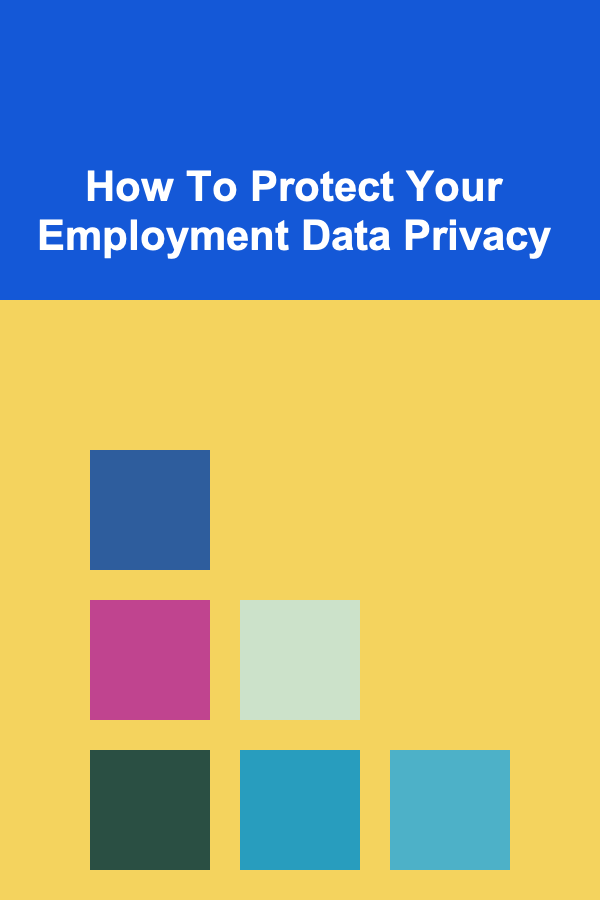
How To Protect Your Employment Data Privacy
ebook include PDF & Audio bundle (Micro Guide)
$12.99$10.99
Limited Time Offer! Order within the next:

In today's interconnected world, the importance of protecting personal data cannot be overstated, especially when it comes to employment data. As the digital age continues to evolve, more and more sensitive information related to our employment---such as job performance, salary details, personal contacts, and other confidential data---is stored and managed online. This article will explore the significance of employment data privacy, the risks associated with it, and, most importantly, how you can protect your personal employment data from potential breaches or misuse.
Why Employment Data Privacy Matters
Employment data refers to the information collected and processed by employers about their employees. This includes, but is not limited to:
- Personal identification details (name, address, phone number, etc.)
- Employment history (previous employers, positions held, responsibilities)
- Payroll and compensation (salary, bonuses, tax information)
- Health and benefits information (medical records, insurance details)
- Performance reviews and disciplinary actions
The protection of such data is essential for several reasons:
- Personal Security: Unauthorized access to employment data can lead to identity theft, financial fraud, and various forms of exploitation.
- Workplace Integrity: Your employment data can reveal sensitive performance reviews or disciplinary actions that, if leaked, may affect your career. Ensuring that your data is kept confidential helps maintain a sense of privacy and control over your professional image.
- Legal Protection: Employers are bound by laws and regulations such as the General Data Protection Regulation (GDPR) in Europe or the California Consumer Privacy Act (CCPA) in the United States to protect employee data. Violations of these laws can lead to significant penalties for employers, but employees also need to take an active role in safeguarding their information.
- Prevention of Discrimination: Employers may hold sensitive data regarding health conditions or other personal characteristics that could lead to discrimination if mishandled. By protecting your data, you also protect yourself from potential discriminatory practices.
Risks to Employment Data Privacy
Despite the growing awareness of privacy risks, many individuals remain unaware of the types of threats their employment data might face. Some common risks include:
1. Data Breaches
One of the biggest threats to employment data privacy is the risk of data breaches. This can occur when hackers or cybercriminals gain unauthorized access to corporate databases or internal networks where employee data is stored. Data breaches may expose sensitive information such as social security numbers, salaries, health records, and more.
2. Phishing and Social Engineering
Phishing attacks are one of the most common methods used by cybercriminals to steal personal information. In these attacks, an individual may receive an email or phone call that appears to be from a legitimate source, such as the HR department or a manager, asking for sensitive information. Unsuspecting employees may inadvertently provide their details, leading to data theft or identity fraud.
3. Inadequate Internal Data Security
Even in companies that prioritize cybersecurity, there may be weaknesses in the internal handling of employment data. If proper security protocols are not followed, employees' data can be exposed to unauthorized internal personnel or contractors. This can be especially concerning when an employee leaves the company or when access control is not enforced rigorously.
4. Misuse of Data by Employers
While most companies treat employment data with respect and care, some may misuse it by sharing it with third-party vendors or using it for purposes other than what was originally intended. For example, your employer may share your personal data with advertisers or use it for targeted marketing, leading to a breach of your privacy rights.
5. Unintentional Data Exposure
With the increasing use of cloud storage and remote working tools, employees may unintentionally expose their employment data. Shared documents or incorrect access settings can allow sensitive information to be exposed to individuals outside the organization.
How to Protect Your Employment Data Privacy
Protecting your employment data requires proactive measures, both on a personal level and in collaboration with your employer. Here are some key steps to ensure your employment data remains secure.
1. Strengthen Your Passwords and Use Multi-Factor Authentication (MFA)
One of the simplest yet most effective ways to protect your employment data is to ensure that you use strong, unique passwords for all accounts and systems related to your employment. A strong password should be:
- At least 12 characters long
- Include a combination of uppercase and lowercase letters, numbers, and special characters
- Avoid using easily guessable information (e.g., birthdays, names, etc.)
In addition to using strong passwords, it's crucial to enable multi-factor authentication (MFA) whenever possible. MFA adds an extra layer of security by requiring a second form of verification, such as a text message or authentication app, in addition to your password.
2. Be Cautious of Phishing Attacks
Phishing attacks are an ever-present threat to your employment data privacy. Always be cautious when receiving unsolicited emails, especially those requesting personal or sensitive information. Key strategies for avoiding phishing scams include:
- Verify the sender's email address: Ensure that the email address is legitimate and matches the company's domain.
- Don't click on suspicious links: Hover over links to see where they lead before clicking, and always ensure they direct you to the official website.
- Avoid opening attachments: Only open attachments from trusted sources. If in doubt, contact the sender to verify the authenticity of the email.
- Look for red flags: Phishing emails often contain spelling mistakes, unusual phrasing, or urgent calls to action like "immediate action required."
3. Limit Data Sharing and Access
Be mindful of how and where you share your personal data. Only provide sensitive information, such as your social security number or salary details, to trusted parties and when absolutely necessary. Avoid sharing sensitive employment data on social media platforms or public forums.
Internally, ensure that your employer has strict access control protocols. This means limiting the number of employees or contractors who can access sensitive data, particularly when it involves payroll, health, or disciplinary records.
4. Ensure Secure Communication Channels
If you need to send or receive sensitive employment data (such as personal information, medical records, or performance reviews), always use secure communication channels. This can include:
- Encrypted email services: Look for email platforms that provide end-to-end encryption, ensuring that only the intended recipient can read the email.
- Secure file sharing platforms: Use trusted, secure platforms for file-sharing, ensuring that data is encrypted both during transfer and while stored.
- Virtual Private Networks (VPNs): If you're working remotely or accessing your company's network, always use a VPN to secure your internet connection and prevent unauthorized access.
5. Regularly Monitor Your Employment Data
Regular monitoring of your employment data can help you detect any potential issues before they escalate. Here are some steps you can take:
- Request copies of your employment records: Periodically ask your employer for copies of your personal information on file to ensure that everything is up to date and accurate.
- Monitor your credit report: In case of a data breach or identity theft, you should regularly check your credit report for signs of fraudulent activity.
- Review performance reviews and disciplinary actions: Ensure that all records kept by your employer are accurate and that no errors have been made in your file that could potentially harm your reputation or future opportunities.
6. Understand Your Privacy Rights
Knowing your privacy rights is an essential part of protecting your employment data. Familiarize yourself with relevant privacy laws that govern how your data should be handled:
- General Data Protection Regulation (GDPR): If you live in the European Union, the GDPR gives you significant control over how your personal data is processed, including employment data.
- California Consumer Privacy Act (CCPA): In California, the CCPA gives you the right to request access to your personal information and have it deleted if desired.
- Health Insurance Portability and Accountability Act (HIPAA): In the United States, HIPAA governs how health-related information should be handled, particularly in the context of employment-related medical records.
Understanding these laws helps you advocate for your data privacy and request action if your data is mishandled.
7. Maintain Physical Security
Although much of our data is digital, physical security still plays a vital role in data protection. Some best practices include:
- Lock your devices: Always lock your computer, smartphone, or any other device that contains personal data when you're not using it.
- Shred sensitive documents: If you handle paper records with personal or employment-related information, ensure that they are shredded properly before disposal.
- Store data securely: If you have physical records that need to be stored, use a secure filing cabinet or lockbox to prevent unauthorized access.
Conclusion
In today's digital age, protecting your employment data privacy is essential not only for your personal security but also for your career and reputation. By following best practices such as using strong passwords, being cautious of phishing attacks, limiting data access, and staying informed about your privacy rights, you can take control of your sensitive employment information and safeguard it from unauthorized access.
Remember, data privacy is a shared responsibility between you and your employer. By remaining vigilant and proactive, you can ensure that your personal employment data remains secure in an increasingly connected world.

How to Create an Allergen-Free Recipe Collection
Read More
How to Create More Space in Your Home with Hidden Storage
Read More
How to Incorporate Personal Touches into Your Supply Organization
Read More
How to Monitor Your Pet's Weight and Maintain Healthy Growth
Read More
How to Use Programming Languages to Make Money
Read More
Mastering the Wheelbarrow: A Comprehensive Guide to Hauling Materials Around Your Yard
Read MoreOther Products

How to Create an Allergen-Free Recipe Collection
Read More
How to Create More Space in Your Home with Hidden Storage
Read More
How to Incorporate Personal Touches into Your Supply Organization
Read More
How to Monitor Your Pet's Weight and Maintain Healthy Growth
Read More
How to Use Programming Languages to Make Money
Read More